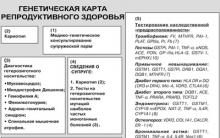The processes of class formation among the Slavs took place against the background of the formation of tribal unions, the collapse big family and the development of a tribal community into a rural (neighborhood). A certain role in the formation of the state was played by undeveloped (compared with the East or the ancient world) slaveholding relations.
form public relations, which existed among the Slavs in the 7th-8th centuries, can be defined as "military democracy". Its signs were: the participation of all members (men) of the tribal union in solving the most important social problems; the special role of the people's assembly as supreme body authorities; general arming of the population (people's militia). This is the equality of all members of society.
The ruling class was formed from two layers: the old tribal aristocracy (leaders, priests, elders) and from community members who got rich on the exploitation of slaves and neighbors. The presence of a neighborhood community (“wire”, “peace”) and patriarchal slavery (when slaves were part of the family that owned them) hampered the process of social differentiation.
Formation of statehood Eastern Slavs coincided with the decomposition of tribal, kinship relations and was due to it. Tribal relations were replaced by territorial, political and military ties. By the 8th century on the territory inhabited by Slavic tribes, 14 tribal unions were formed, which arose as military associations. The organization and preservation of these formations required strengthening the power of the leader and the ruling elite. As the main military force and at the same time the ruling social group at the head of such unions were the prince and the princely squad.
Structure of public administration:
People's Assembly (Veche), at which all the most important issues of governance were decided;
At the head of the union of tribes was the prince - the military leader, initially elected at the people's assembly (later his power became hereditary). The prince was the highest person in the executive power of the tribal government;
Council of Elders.
Trends in the development of public relations:
The role of the prince in managing the union of tribes increased;
Under the prince, a squad was formed - a special organization connected not by family ties, but by the community of military and property interests and loyalty to the military leader - the prince;
The role of the people's assembly and the council of elders decreased, the people's assembly turned into an assembly of warriors, to whom the prince and his squad could dictate their will,
Under the prince, a council was formed, which included wealthy combatants and representatives of the tribal nobility.
These trends indicate the process of transformation of public self-government bodies into state bodies:
A special public authority, which does not coincide with the population, is separated from it, has a special administrative apparatus, armed forces (retinue) and extends to a certain territory;
The formation of property inequality and private property creates opportunities for collecting taxes (tribute) in favor of the state.
Tribal unions for military-political purposes formed larger political formations - “unions of unions”, which in fact were state-type formations.
In the 7th century the largest unions were: Kuyaba (with a center in Kyiv), Artania (with a center in Ryazan), Slavia (with a center in Novgorod).
Feudal fragmentation, city-states. Moscow principality (XII-XV centuries);
Feudal fragmentation is a natural stage in the development of society. Other feudal states also passed this stage. Political fragmentation has become new form organization of Russian statehood in the conditions of the development of the country's territory and its further development.
In the independent lands of Russia, the economy developed, for example, on the eve of the Mongol invasion, there were already about 300 cities, arable farming was spreading, and tools were being improved.
However, fragmentation caused a weakening of the country's military potential, which had a tragic effect during Mongol invasion to Russia.
Causes of feudal fragmentation:
The growth of the population and military potential in different regions of Russia became the basis for the formation of sovereign principalities.
Princely and boyar estates had a natural character. They sought to satisfy their needs as much as possible at the expense of internal resources. This, on the one hand, strengthened their sovereignty, and on the other, weakened the power of the Grand Duke.
The dominance of subsistence economy gave each region the opportunity to separate from the center and exist as an independent land or principality. Now the princes fought not to seize power throughout the country, but to expand the borders of their principality at the expense of their neighbors, they took care of strengthening their lands.
Further economic development of individual lands and principalities led to inevitable social conflicts. To resolve them, a strong local government was needed. Local boyars no longer wanted to depend on the central government in Kyiv. The main force of the disunity process was the boyars. Based on his power, the local princes managed to establish their power in every land. However, later between the boyars and the local princes, contradictions arose, a struggle for influence and power.
The Grand Duke no longer had the strength or power to prevent or even stop the political disintegration of the unified state. The weakening of the central government led to the fact that Kievan Rus broke up into a number of sovereign principalities.
Grand Duchy of Moscow
It stood out from the Vladimir Grand Duchy at the end of the 13th century as the inheritance of the youngest son of Alexander Nevsky - Daniel. In the first years of the XIV century, it annexed a number of adjacent territories and began to compete with the Tver principality. In 1328, together with the Horde and Suzdal, Tver was defeated, and soon the Moscow prince Ivan I Kalita became the Grand Duke of Vladimir. Subsequently, the title, with rare exceptions, was retained by his offspring. After the victory at the Kulikovo field, Moscow secured the importance of the center of the unification of Russian lands. In 1389, Dmitry Donskoy bequeathed the great reign to his son Vasily I, which was recognized by all the neighbors of Moscow and the Horde.
In 1439, the Moscow metropolis of "All Russia" did not recognize the Florentine Union of the Greek and Roman churches and became, in fact, autocephalous.
After the reign of Ivan III (1462), the process of unification of the Russian principalities under the rule of Moscow entered a decisive phase. By the end of the reign of Vasily III (1533), Moscow became the center of the Russian centralized state, having annexed, in addition to all of North-Eastern Russia and Novgorod, also the Smolensk and Chernigov lands conquered from Lithuania. In 1547 Grand Duke Moscow Ivan IV was crowned king. In 1549 the first Zemsky Sobor. In 1589, the Moscow metropolis was transformed into a patriarchy. In 1591, the last lot was liquidated in the kingdom.
Introduction 3
1. The emergence of statehood among the Eastern Slavs 4
2. Kievan Rus as an early feudal monarchy 5
3. The formation of ancient Russian law. Russian Truth 8
Conclusion 16
List of used literature 17
Introduction
In the VI century. from a single Slavic community, the East Slavic branch stands out (future Russian, Ukrainian, Belarusian peoples). Approximately this time is the emergence of large tribal unions.
The formation of the state among the Eastern Slavs was a logical result of a long process of decomposition of the tribal system and the transition to a class society. The process of property and social stratification among the community members led to the separation of the most prosperous part from their midst. The tribal nobility and the prosperous part of the community, subjugating the mass of ordinary community members, needs to maintain their dominance in state structures.
The embryonic form of statehood was represented by the East Slavic unions of tribes, which united in superunions, however, fragile ones. One of these associations was, apparently, the union of tribes headed by Prince Kiy. Eastern historians talk about the existence on the eve of education Old Russian state three large associations of Slavic tribes: Kuyaby, Slavia and Artania. Kuyaba, or Kuyava, then called the area around Kyiv. Slavia occupied the territory in the area of Lake Ilmen. Its center was Novgorod. The location of Artania - the third major association of Slavs - has not been precisely established.
IN control work we will talk about the issues of the emergence of statehood among the Eastern Slavs, about Kievan Rus as an early feudal monarchy, Russkaya Pravda and the formation of Old Russian law.
1. The emergence of statehood among the Eastern Slavs
According to The Tale of Bygone Years, the Russian princely dynasty originates in Novgorod. In 859, the Northern Slavic tribes, who then paid tribute to the Varangians, or Normans (according to most historians, immigrants from Scandinavia), drove them across the sea. However, soon after these events, internecine struggle began in Novgorod. To stop the clashes, the Novgorodians decided to invite the Varangian princes as a force standing above the opposing factions. In 862, Prince Rurik and his two brothers were called to Russia by the Novgorodians, marking the beginning of the Russian princely dynasty.
The date of formation of the Old Russian state is conditionally considered to be 882, when Prince Oleg, who seized power in Novgorod after the death of Rurik (some chroniclers call him the governor of Rurik), undertook a campaign against Kyiv. Having killed Askold and Dir, who reigned there, for the first time he united the northern and southern lands as part of a single state. Since the capital was moved from Novgorod to Kyiv, this state is often called Kievan Rus.
Kievan Rus 9th–10th centuries - the first state of the Eastern Slavs, uniting more than 200 small Slavic, Finno-Ugric and Latvian-Lithuanian tribes. The term "Kievan Rus" is very convenient for designating a certain chronological period - the 9th - the beginning of the 12th century, when Kyiv stood at the head of a huge state that opened a new, feudal period in the history of the peoples of Eastern Europe, a period that replaced primitiveness and lasted almost a thousand years.
But custom is the oldest source of law. The earliest monument of Russian law is the text of treaties between Russia and Byzantium (911, 944 and 971). the texts contain norms of Byzantine and Russian law relating to international, commercial, procedural and criminal law. They contain references to the "Russian law", which is a set of customary law.
2. Kievan Rus as an early feudal monarchy
Here it is impossible to characterize the entire centuries-old history of relations between Russia and Byzantium, starting with the visit to Constantinople of the first (who ruled at the turn of the 8th-9th centuries) Kiev prince Kiy, who, according to the chronicle, “received great honor” from the Byzantine emperor. Let us dwell only on the first military clash between the Russians and the Byzantines. On June 18, 860, the Russian army laid siege to Constantinople (information about earlier similar attacks is unreliable). The latest research has shown that this campaign was carried out under the dictates of the Khazar Khaganate. This is undeniably clear, in particular, from the fact that in the same year 860, Byzantium sent an embassy led by Saints Cyril and Methodius not to Kyiv, but to the then capital of the Khazar Khaganate - Semender in the North Caucasus (there are, however, serious reasons to believe that on the way back this embassy also visited Kyiv). I also note that in one of the later Byzantine writings, the leader of the campaign against Constantinople (it was, obviously, the Kyiv prince Askold) is accurately defined as the “voivode of the kagan” (that is, the ruler of the Khazars).
Of particular, even exceptional significance for us are the stories of a direct witness and direct participant in the events of one of the most prominent figures in Byzantium in its entire history, the Patriarch of Constantinople, St. Photius (by the way, he calls the Russians a “slave” people - meaning, as they believe, the then subordination of Russia Khazar Khaganate; It was on his initiative that an embassy of his great disciples, Sts. Cyril and Methodius).
St. Photius testified that in June 860 Constantinople “was almost raised on a spear”, that it was “easy for the Russians to take it, and it was impossible for the inhabitants to defend it”, that “the salvation of the city was in the hands of the enemies and its preservation depended on their generosity. .. the city was not taken by their grace”, etc. Photius was even stung, as he noted, by "the disgrace of this generosity." But one way or another, on June 25, the inhabitants of Constantinople unexpectedly “saw the enemies ... retreating, and the city, which was threatened with plunder, got rid of ruin.”
Subsequently, in the 11th century, the Byzantine chroniclers, not wanting, in all likelihood, to recognize this Russian “generosity”, invented that a storm, by divine will, scattered the attacking fleet (this fiction was also accepted by our chronicle). Meanwhile, Photius, an eyewitness to the events, unambiguously reports that during the Russian invasion, “the sea quietly and serenely spread its backbone, giving them a pleasant and longed-for voyage.”
Early feudal society is not identical to feudal society. It has not yet developed to a mature state the main character traits feudal formation and there are many phenomena inherent in previous formations. It is not so much about the predominance of one or another way of life at the moment, but about the development trend, about which of the ways is developing and which are gradually dying out. In the ancient Russian state, the future belonged precisely to the feudal way of life.
The political system of the Old Russian state combined the institutions of the new feudal formation and the old, primitive communal one. The hereditary prince was at the head of the state. The rulers of other principalities were subordinate to the Kiev prince. Only a few of them are known to us from the chronicle. However, the treaties of Oleg and Igor with Byzantium contain a mention that there were quite a few of them.
The prince was a legislator, a military leader, a supreme judge, an addressee of tribute. The functions of the prince are precisely defined in the legend about the calling of the Varangians: "to rule and judge by law." The prince was surrounded by a squad. The warriors lived in the princely court, feasted with the prince, participated in campaigns, shared tribute and military booty. The relationship between the prince and the warriors was far from the relationship of allegiance. The prince consulted with the squad on all matters. At the same time, the squad needed the prince, but not only as a real military leader, but also as a kind of symbol of statehood.
The most respected, senior warriors, who made up the permanent council, the “thought” of the prince, began to be called boyars. Some of them may have had their own squad. The terms “lads”, “chad”, “gridi” were used to designate the younger squad. If the boyars acted as governors, then the junior combatants performed the duties of administrative agents: swordsmen (bailiffs), virniks (fine collectors), etc. The princely retinue, detached from the community, dividing tribute among themselves, represented the emerging class of feudal lords.
Princely power was also limited by elements of the remaining popular self-government. The people's assembly - veche - acted actively in the 9th-11th centuries. and later. The people's elders - the "old men of the city" - participated in the princely duma, and without their consent it was apparently difficult to make this or that decision. The chronicles reflected the decline in the role of the veche in political life: his mention is usually associated with extraordinary situations when the weakened princely administration either needed additional support or lost power. However, there were exceptions: strong positions preserved the people's assembly in Novgorod and a number of other cities.
An analysis of socio-political structures allows us to speak of three centers of gravity that influenced community development: this is, first of all, the princely power, the squad (boyars), the people's veche, which was gaining strength. In the future, it is the ratio of these power elements that will determine one or another type of statehood that will prevail in the territories that were once part of the Rurik dynasty.
In the XII century, the most important officials were: courtier - in charge of all princely households; governor - commander of all the armed forces of the principality; stable tiun - was responsible for the princely stables; stolnik - was in charge of organizing the supply of food to the princely court. Smaller officials were tiuns and elders.
The division of principalities into administrative units was not clear. The chronicles mention the parish, churchyard. The princes exercised local government in cities and volosts through posadniks and volosts, who were representatives of the prince. From the middle of the XII century, instead of posadniks, the position of governors was introduced. Officials of the local administration did not receive a salary from the Grand Duke, but were kept at the expense of extortions from the population. Such a system is called a feeding system.
The body of local peasant self-government was the verv - a rural territorial community.
The power of the prince and his administration extended to cities and the population of lands that were not the property of the boyars. Boyar estates gradually acquire immunity and are exempted from princely jurisdiction. The population of these estates becomes completely subject to the boyars-proprietors.
Free download
The processes of class formation among the Slavs took place against the background of the formation of tribal unions, the collapse of a large family and the development of a tribal community into a neighboring one. A certain role was played by undeveloped slaveholding relations.
The form of social relations of the Slavs in the VII-VIII centuries. can be defined as a military democracy. Its signs were: the participation of all members (men) of the tribal union in solving the most important social problems; the special role of the people's assembly as the supreme organ of power; general arming of the population
The ruling stratum was formed from the old tribal aristocracy (leaders) and members of the community, who got rich on the exploitation of slaves and neighbors. The presence of a neighborhood community and patriarchal slavery hindered the process of social development.
The formation of statehood among the Eastern Slavs coincided with the disintegration of tribal relations. They were replaced by territorial, political and military ties. By the 8th century on the territory inhabited by Slavic tribes, 14 tribal unions were formed, which arose as military associations. The organization and preservation of these formations required strengthening the power of the leader and the ruling elite. As the main military force and at the same time the ruling social group, such unions were headed by the prince and
princely squad.
Tribal unions for military-political purposes are combined into even larger formations - “unions of unions”. Kyiv became the center of one of them. The sources mention three large political centers that can be considered proto-state associations: Kuyaba (Kyiv), Slavia (Novgorod), Artania (Ryazan). In the ninth century most of the Slavic tribes merge into the territorial union "Russian Land". The center of the association was Kyiv.
In 882, the two largest political centers of the ancient Slavs. Kyiv and Novgorod, united under the rule of Kyiv, forming the Old Russian state. From the end of the 9th to the beginning of the 11th century. this state included the territories of other Slavic tribes - the Drevlyans, Severyans, Radimichi, Ulichs, Tivertsy, Vyatichi. At the center of the new state formation was the Glade tribe.
The territory of the Kievan state was concentrated around several political centers that were once tribal. In the second half of the XI - the beginning of the XII century. within the boundaries of Kievan Rus, fairly stable principalities-semi-states began to form: Kyiv, Chernigov, Pereyaslav lands.
In the IX-XI centuries. in the formation of ancient Russian statehood, the “Varangian element” played a certain role, around which a long polemic was conducted in historical literature between supporters and opponents of the “Norman theory” of the origin of the ancient Russian state. IN
This process, undoubtedly, was affected by the influence of immigrants from Scandinavia and the Baltic.
Novgorod was an ancient tribal center. Novgorod carried out expansion by spreading tribute and court to new territories, but its
the rapid pace led to great fragmentation of the feudal estates. In the struggle with Novgorod, the Kyiv prince Yaroslav ceded Ladoga and Pskov to him. From the 11th century Novgorod expansion is suspended by oncoming traffic from Polotsk and Smolensk.
By the middle of the XII century. (Polozov) all the territories of the “semi-states” that made up the Kievan state merge into one. The name "Russian Land", previously referring only to southern Russia, extends to the entire territory of the state, which united more than 20 peoples and tribes.
More on the topic The emergence of statehood among the Eastern Slavs .:
- 1.1. The emergence of supreme power among the Eastern Slavs and the formation of a system of principalities
- 1.3. Customary law of the Eastern Slavs and monuments of law of the X-XIH centuries.
- THE RISE OF STATEHOOD AT THE SLAVES. FORMATION OF THE OLD RUSSIAN STATE. THEORIES OF THE ORIGIN OF THE OLD RUSSIAN STATE
The emergence of the state is a natural stage in the development of society. This is a very long process, so any event that marks the transition to state forms of people's life is very conditional.
Primitive society could exist, guided by two basic principles that regulated social life: custom (tradition) and the right of the strong. These principles were sufficient as long as the kindred did not differ too much from each other in their interests and aspirations. Age-old traditions were rarely challenged, so there was no need for any special mechanism, designed to ensure their observance, i.e. in the state.
However, primitive society was gradually changing, relations between relatives became more and more diverse, and the life of the clan became less and less closed. We have already mentioned the disintegration of the tribal community and the transition to a neighboring community among the Eastern Slavs. The interests of an individual family no longer always coincided with common interests that destroyed the race from the inside. There was a need to create new, more complex rules (gradually taking the form of legal norms and laws) and enforce them. Inequality of property, inequality of opportunities appeared, as not only the economic basis of people's lives improved, but also the sources from which people drew their livelihoods became more diverse. For example, in the life of the family, spoils of war began to play an increasingly important role. These factors influenced the emergence of property inequality between people, which was enshrined in the right of private property.
Of course, it would be wrong to deny the economic factor in the emergence of the state (the growth of labor productivity, the emergence of surpluses, inequality, etc.), but it is also impossible to reduce everything only to the economic activity of people.
The state arises when the majority of members of society have a need to limit tribal power (the patriarchal power of the elders, based on tradition and their own moral authority). At first, the main functions of state power were court and war (protection of the community members engaged in productive labor, who took up arms only in case of a particularly serious threat; ensuring the security of trade relations; predatory raids on neighbors).
The emergence of Kievan Rus chronologically fits into the process of state formation, which took place in the 9th-10th centuries. in Northern, Central and Eastern Europe. In the first half of the ninth century the Great Moravian principality was formed, at the turn of the 9th–10th centuries. - Czech. In the middle of the ninth century there was an unification of Polish tribes, and in the second half of the 10th century. The Old Polish state was created. In the ninth century statehood was established in Croatia and Serbian lands. 9th century - the time of the appearance of the united Anglo-Saxon kingdom, and the tenth century. - Danish.
In the VIII-IX centuries. among the Eastern Slavs, the tribal way of life was thoroughly destroyed and was not a serious obstacle to the emergence of the state. Neighboring communities could no longer be governed on the basis of the old tribal customs. All this required the creation of new rules, new norms of the hostel.
Neighboring communities and individual family yards were too weak to provide their own security. The natural guarantor of security was the prince, who had a squad and a fortified point (city). The agricultural communities gradually came under the patronage of the prince and his retinue. In the ninth century continued gradual strengthening of princely power. This process was accelerated under the influence of external factors: in the north of the East European Plain, raids by the Varangians became a constant phenomenon, in the south, the enmity between the Slavic and Turkic tribes escalated.
In historical science, a dispute arose a long time ago about the formation of statehood among the Slavs. For many years enjoyed great prestige Norman theory, in which the role of Scandinavian warriors in the formation of East Slavic statehood was exaggerated. It is also wrong to downplay the role of the Varangians in the political processes that took place in Slavic society, since extreme anti-Normanism conflicts with the facts known to us. It can be said that the state of the Eastern Slavs was formed not thanks to the Scandinavians, but with their participation.
In The Tale of Bygone Years, the chronicler reports that in 862 Novgorod elder Gostomysl, being childless, before his death invited the Norman prince Rurik with his retinue to Novgorod. Rurik, having killed the noble Novgorodians, settled in the city and began to rule. After his death, the leader of one of the Varangian detachments, Oleg, seized power. IN 882 Oleg undertook a campaign against Kyiv. He managed by cunning to lure the Varangians Askold and Dir from Kyiv, which they had previously captured, and killed them. The capture of Kyiv made it possible to politically unite the territories located along the route "from the Varangians to the Greeks." Oleg, who made Kyiv his capital city, continued to rule over the Novgorodians.
The unification of most of the East Slavic tribes around Kyiv was not very strong and not very burdensome. The power of the Kiev prince was reduced to collecting tribute (polyudyu) and inter-tribal disputes and litigation.
After the death of Oleg, the son of Rurik, Igor, began to reign in Kyiv. At the same time, the prince 945 the first uprising of the Drevlyans took place. The insatiability of Prince Igor during the collection of tribute outraged the Drevlyans - they killed the squad, and the prince was executed. Igor's wife Olga, having avenged the Drevlyans for the murder of her husband, was nevertheless forced to streamline the collection of tribute, establishing lessons(tribute amount) and churchyards(gathering places).
So gradually, under the rule of Kyiv (around the Polyan tribe), the Old Russian state, Kievan Rus, was formed. It was an early feudal state, as it retained the remnants of the tribal system: elements of military democracy (the relationship between the prince and the squad, the militia), the existence of veche in various cities and tribal associations, blood feud.
At the head of the state was the Grand Duke of Kyiv, under which there was a council of the most noble and powerful princes and boyars. The princely combatants were in charge of collecting tribute, taxes, carried out the court, sorted out petty cases, etc. Special princely representatives (posadniks) were appointed to the cities. In vassal dependence on the prince were his relatives, the princes of specific lands, the boyars, who owned large estates and had their own squad.
There is a gradual strengthening of the power of the Kiev princes over the tribal unions of the Slavs. The Kyiv prince united Slavic and non-Slavic lands both by force and through various agreements. Oleg conquered the Drevlyans by force, Vladimir in the same way attached the Radimichi. By the time of the reign of Svyatoslav, the tribal princes were basically done away with - they became simply posadniks of the Kiev prince. Prince Vladimir planted his sons in various lands dependent on Kyiv. However, the prince did not reign supreme. The princely power was limited by the elements of the preserved people's self-government. Actively operated in the IX-XI centuries. national assembly - veche.
At the very beginning of the article, it should be noted that the question of the emergence of statehood among the Eastern Slavs is complex and ambiguous. Many books and scientific works are devoted to him. In a couple of paragraphs, one cannot reveal all the versatility and depth of the topic. The purpose of this text is to create a general picture in the reader's head, an attempt to interest him in expanding knowledge and give an idea of the past.
It was determined that the formation of the state among the Eastern Slavs took place from the 4th to the 9th centuries. The beginning of Kievan Rus is considered to be 882, when the Prophetic Oleg united Novgorod and Kyiv. Even earlier, in 862, Varangian prince Rurik was called to reign in Novgorod - some scientists call this date the countdown of statehood.
The emergence of statehood among the Eastern Slavs
What did the calling of the Varangians testify to? The fact that by that time some kind of state apparatus had already been formed, and, roughly speaking, Rurik had a place to invite - this is exactly what the “pro-Slavic” theory says.
The Norman theory, in contrast, claims that the statehood of the Eastern Slavs was entirely and completely formed thanks to the Varangian princes.
cold war between two views Slavic history continues to this day. It does not allow to overcome a small number of sources. In this situation, scientific ethics becomes especially important, because in order to prove their case, the parties are ready for destructive for world history, unethical actions, such as hushing up objectionable facts.
The modern view of the historical dispute is one of compromise. If we talk about the most common point of view in Russia (in particular, taught in schools), then it sounds like this: “Yes, the Varangians were called to reign and contributed to the establishment of order in the lands of the Slavs, but the main process of the emergence of the state proceeded from a number of patterns and reasons which the Normans did not influence at all.
Namely:
- Even before the calling of Rurik, the transition from the tribal community to the neighboring one began. An important milestone in the development of peoples.
- The Eastern Slavs, despite the division of tribes, already existed mutual language.
Until the 9th century there was social stratification. The Slavs already had their own princes, tribal nobility.
- The Slavs formed clear boundaries of their lands.
- Even before the calling of Rurik, a craft was formed and the economy developed. The slash-and-burn method, beekeeping, etc. already existed.
- long before the advent ancient state Eastern Slavs already had money.
- Pravoslavian self-consciousness arose long before the reign of Rurik on the Danube, that is, even then the Slavs considered themselves to be a single people.
Tale of Bygone Years
One of the main sources of information about the emergence of the state of the Eastern Slavs is the Tale of Bygone Years. This cultural monument is truly priceless and has helped researchers more than once. But, as you know, more than two sources are needed to confirm the fact. And with a critical approach, it often turned out that The Tale of Bygone Years did not accurately convey the events, but somewhere the author completely mystified the events.
 Tale of Bygone Years
Tale of Bygone Years
The role of the state in the life of the Slavs themselves was as great as the role of nature, which gave life. The entire history of Russia from Kievan Rus to modern times suggests that the state was power-centric. And the origins of this phenomenon lie just in antiquity, when the glade, drevlyans, rodimichi, krivichi, slovenes and a number of other tribes organized themselves into a huge country in eastern Europe. The Slavs had to endure difficult natural conditions and constant raids by nomads. Because of this situation, a tough state was formed. an apparatus that used violence to a large extent more than other methods.











How to cook frozen cutlets in a pan?
Pike perch baked in salt
How should a girl behave in a relationship with a guy so that he falls in love?
How osteochondrosis manifests itself on an x-ray Visible signs on the human body of osteochondrosis
What can be prepared for the festive table for Easter Easter table decoration and recipes